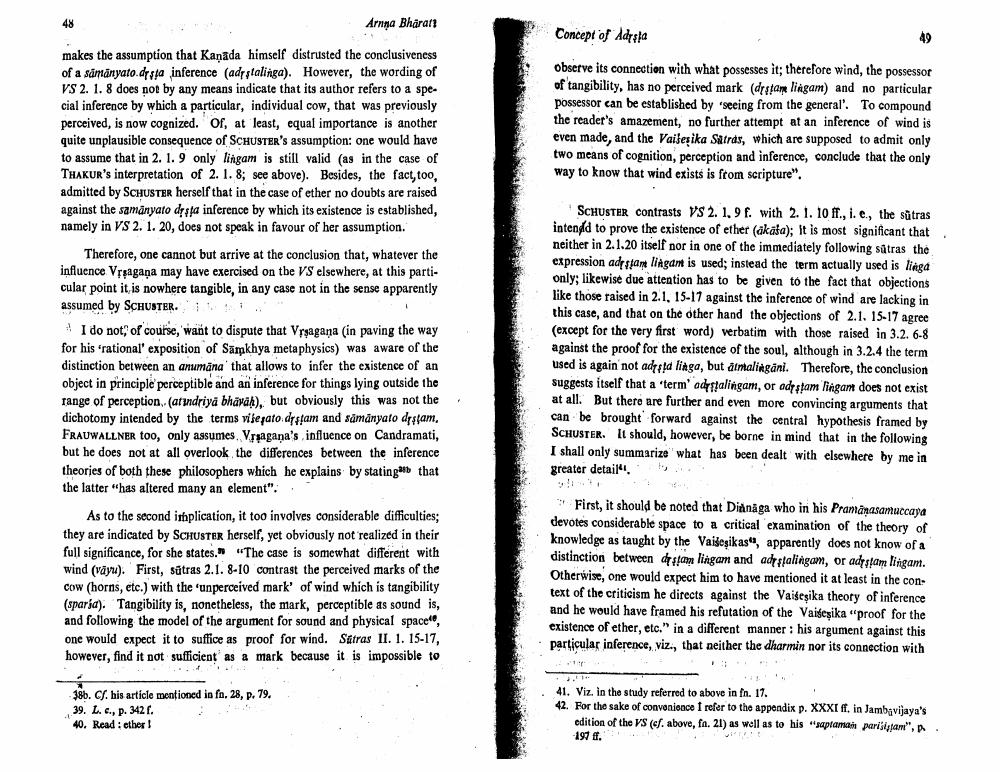Book Title: Note On Concept Adrsta As Used In Vaisesika Sutra Author(s): A Wezler Publisher: A Wezler View full book textPage 8
________________ Anna Bharart Concept of Adesta makes the assumption that Kaņāda himself distrusted the conclusiveness of a sámányato.desta inference (adrptalinga). However, the wording of VS 2. 1. 8 does not by any means indicate that its author refers to a special inference by which a particular, individual cow, that was previously perceived, is now cognized. Of, at least, equal importance is another quite unplausible consequence of SCHUSTER's assumption: one would have to assume that in 2. 1. 9 only lingam is still valid (as in the case of THAKUR's interpretation of 2. 1. 8; see above). Besides, the fact, too, admitted by SCHUSTER herself that in the case of ether no doubts are raised against the samányato di sta inference by which its existence is established, namely in VS 2. 1. 20, does not speak in favour of her assumption. observe its connection with what possesses it; therefore wind, the possessor of tangibility, has no perceived mark (drstan lingam) and no particular possessor can be established by seeing from the general'. To compound the reader's amazement, no further attempt at an inference of wind is even made, and the Vaifesika Satras, which are supposed to admit only two means of cognition, perception and inference, conclude that the only way to know that wind exists is from scripture". Therefore, one cannot but arrive at the conclusion that, whatever the influence Vrsagana may have exercised on the VS elsewhere, at this particular point it is nowhere tangible, in any case not in the sense apparently assumed by SCHUSTER. I do not of course, want to dispute that Vrsagaña (in paving the way for his rational exposition of Sāmkhya metaphysics) was aware of the distinction between an anumāna that allows to infer the existence of an object in principle perceptible and an inference for things lying outside the range of perception (at undriya bhāvah), but obviously this was not the dichotomy intended by the terms viberato drsam and sámányato dostam, FRAUWALLNER too, only assumes. Vrsagana's influence on Candramati, but he does not at all overlook the differences between the inference theories of both these philosophers which he explains by statingant that the latter "has altered many an element". SCHUSTER contrasts VS 2. 1.9 f. with 2. 1. 10 ff., I. e., the sûtras intend to prove the existence of ether (akafa); It is most significant that neither in 2.1.20 itself nor in one of the immediately following sätras the expression adrsant liagant is used; instead the term actually used is linga only; likewise due attention has to be given to the fact that objections like those raised in 2.1, 15-17 against the inference of wind are lacking in this case, and that on the other hand the objections of 2.1. 15-17 agree (except for the very first word) Verbatim with those raised in 3.2. 6-8 against the proof for the existence of the soul, although in 3.2.4 the term used is again not adosta linga, but almalingani. Therefore, the conclusion Suggests itself that a 'term' ad salingam, or adestam lingant does not exist at all. But there are further and even more convincing arguments that can be brought forward against the central hypothesis framed by SCHUSTER. It should, however, be borne in mind that in the following I shall only summarize what has been dealt with elsewhere by me in greater detail As to the second implication, it too involves considerable difficulties; they are indicated by SCHUSTER herself, yet obviously not realized in their full significance, for she states. "The case is somewhat different with wind (väyu). First, sūtras 2.1. 8-10 contrast the perceived marks of the Cow (horns, etc.) with the 'unperceived mark' of wind which is tangibility (sparia). Tangibility is, nonetheless, the mark, perceptible as sound is, and following the model of the argument for sound and physical space, one would expect it to suffice as proof for wind. Satras II. 1. 15-17, however, find it not sufficient as a mark because it is impossible to * First, it should be noted that Dianaga who in his Pramānasamuccaya devotes considerable space to a critical examination of the theory of knowledge as taught by the Vaiseşikas, apparently does not know of a distinction between die stam lingam and adestalingam, or adestam lingam. Otherwise, one would expect him to have mentioned it at least in the con text of the criticism he directs against the Vaisesika theory of inference and he would have framed his refutation of the Vaiseșika "proof for the existence of ether, etc." in a different manner : his argument against this particular inference, viz., that neither the charmin nor its connection with 386. CS. his article mentioned in fo. 28, p. 79. 39. L. c., p. 342 f. 40. Read : ether! 41. Viz. in the study referred to above in fn. 17. 42. For the sake of convenience refer to the appendix p. XXXI ff. in Jambgvijaya's edition of the VS (ef. above, fo. 21) as well as to his "saptaman parišsami", 1978. .Page Navigation
1 ... 6 7 8 9 10 11 12 13
